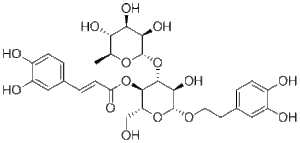Verbascoside (Acteoside; Kusaginin; TJC160)
This product is for research use only, not for human use. We do not sell to patients.

For small sizes, please check our retail website as below: www.invivochem.com
| Size | Price | Stock |
|---|---|---|
| 250mg | $1050 | To Beconfirmed |
| 500mg | $1750 | To Beconfirmed |
| 1g | $2625 | To Beconfirmed |
Cat #: V16477 CAS #: 61276-17-3 Purity ≥ 98%
Description: Verbascoside (Acteoside; Kusaginin; TJC-160), a natural product isolated from Lantana camara, is novel and potent inhibitor of the Oligomerization of Pneumolysin.
Top Publications Citing Invivochem Products
Publications Citing InvivoChem Products
Product Promise

- Physicochemical and Storage Information
- Protocol
- Related Biological Data
- Stock Solution Preparation
- Quality Control Documentation
| Molecular Weight (MW) | 624.59 |
|---|---|
| Molecular Formula | C29H36O15 |
| CAS No. | 61276-17-3 |
| SMILES Code | O=C(O[C@@H]1[C@@H](CO)O[C@@H](OCCC2=CC=C(O)C(O)=C2)[C@H](O)[C@H]1O[C@@H]3O[C@@H](C)[C@H](O)[C@@H](O)[C@H]3O)/C=C/C4=CC=C(O)C(O)=C4 |
| Synonyms | Verbascoside |
| Protocol | In Vitro | Verbascoside acts as an ATP-competitive inhibitor of PKC, with an IC50 of 25 µM. Verbascoside shows Kis of 22 and 28 µM with respect to ATP and histone, respectively. Verbascoside has potent antitumor activity against L-1210 cells, with an IC50 of 13 µM. |
|---|---|---|
| In Vivo | Verbascoside (1%) reduces the overall scratching behavior incidence as well as the severity of the skin lesions in 2,4-dinitrochlorobenzene (DNCB)-induced atopic dermatitis (AD) mice model. Verbascoside also blocks DNCB-induced expression of proinflammatory cytokine TNF-α, IL-6, and IL-4 mRNA in skin lesions. |
These protocols are for reference only. InvivoChem does not
independently validate these methods.
| Solvent volume to be added | Mass (the weight of a compound) | |||
|---|---|---|---|---|
| Mother liquor concentration | 1mg | 5mg | 10mg | 20mg |
| 1mM | 1.6011 mL | 8.0053 mL | 16.0105 mL | 32.0210 mL |
| 5mM | 0.3202 mL | 1.6011 mL | 3.2021 mL | 6.4042 mL |
| 10mM | 0.1601 mL | 0.8005 mL | 1.6011 mL | 3.2021 mL |
| 20mM | 0.0801 mL | 0.4003 mL | 0.8005 mL | 1.6011 mL |
The molarity calculator equation
Mass(g) = Concentration(mol/L) × Volume(L) × Molecular Weight(g/mol)
Mass
=
Concentration
×
Volume
×
Molecular Weight*
The dilution calculator equation
Concentration(start)
×
Volume(start)
=
Concentration(final)
×
Volume(final)
This equation is commonly abbreviated as: C1 V1 = C2 V2
Concentration(start)
C1
×
Volume(start)
V1
=
Concentration(final)
C2
×
Volume(final)
V2
Step One: Enter information below
Dosage mg/kg
Average weight of animals g
Dosing volume per animal µL
Number of animals
Step Two: Enter the in vivo formulation
%DMSO
+
%
+
%Tween 80
+
%ddH2O
Calculation Results:
Working concentration:
mg/ml;
Method for preparing DMSO master liquid:
mg
drug pre-dissolved in
µL
DMSO(Master liquid concentration
mg/mL)
,Please contact us first if the concentration exceeds the DMSO solubility of the batch of drug.
Method for preparing in vivo formulation:
Take
µL
DMSO master liquid, next add
µL
PEG300, mix and clarify, next add
µL
Tween 80,mix and clarify, next add
µL
ddH2O,mix and clarify.
Note:
- (1) Please be sure that the solution is clear before the addition of next solvent. Dissolution methods like vortex, ultrasound or warming and heat may be used to aid dissolving.
- (2) Be sure to add the solvent(s) in order.




































